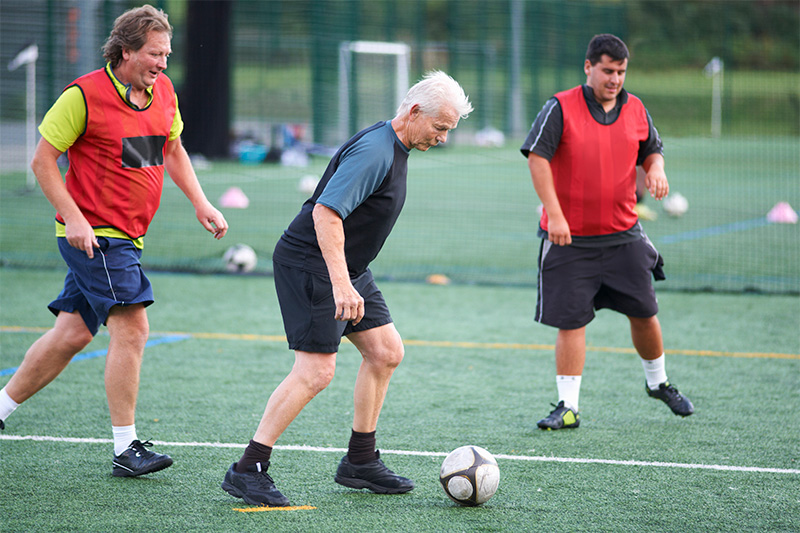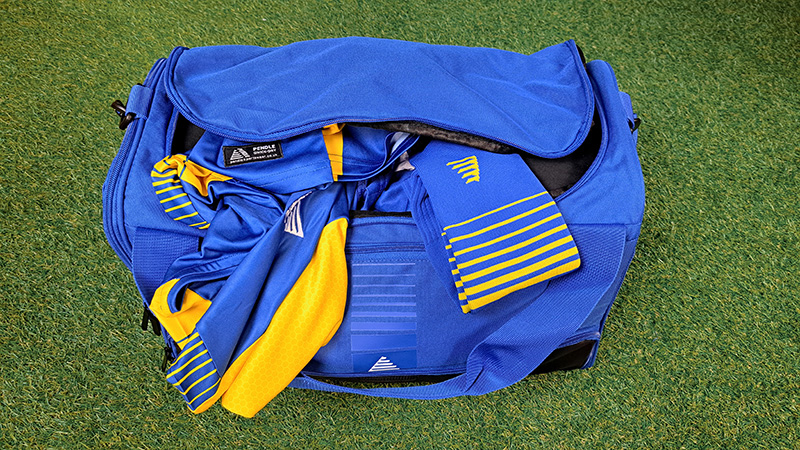Last Updated on: 11th April 2025, 10:09 am
Football is something that everyone can enjoy, regardless of age, fitness, or ability. Nothing shows that more than walking football. The increasingly popular sport opens up new opportunities for more people to get onto the pitch. This includes those who have never played before and those who haven’t played in years.
Thinking about getting involved in walking football? Let’s explore why it’s a great idea.

What is Walking Football?
John Croot created walking football in 2011, and it has been getting more popular every year. You can walk as fast as you want, but running or jogging is not allowed. Games are typically 6-a-side and played on small pitches with small goals. It’s classed as a no-contact sport, and slide tackles aren’t allowed.
Walking football can still be competitive, but the focus is on fitness, safety, and the social aspects.
How does walking football differ from regular football?
Walking football keeps the major aspects of the game but includes a few key differences. These rules make it more accessible to older players:
- No running: The main difference is no running or jogging. Always keep one foot in contact with the ground.
- Non-contact: Tackling is either limited or completely prohibited, depending on the league. This prevents injuries.
- Smaller pitch, smaller teams: Games are typically 5-a-side or 6-a-side, with reduced pitch sizes for manageability.
- Low-impact play: This makes the sport perfect for anyone with joint issues or returning to exercise.
Who Can Play?
Walking football was originally designed for people over 50 as a great way to keep fit. Over time, it has grown to include a wider range of people. Walking football can be great for:
- People over 50
- Anyone recovering from injury
- Someone with limited mobility
- People wanting a gentle way back into the sport
- Players with chronic illnesses
Really, the sport can be great for players of all ages and fitness levels. The low-impact approach is a great way to get into the sport and start your fitness journey.

Purpose of Walking Football
Walking football offers a slower-paced and safer way for certain players to enjoy the sport. Its focus is on the social aspects of the game rather than the competition. It also promotes cardiovascular fitness without putting as much stress on the body.
Ultimately, walking football allows more players to enjoy the game and get on the pitch. It’s no wonder it’s such a hit with all sorts of players.
Health Benefits
Walking football might be low impact, but that doesn’t mean there are no health benefits. Playing can be great for both your body and mind:
- Boosts cardiovascular health
- Improves balance, strength, and coordination
- Aids in weight management
- Encourages mental well-being and reduces social isolation
This is why walking football is a great form of low-impact exercise for older adults. The rules of the game have been written to reduce the risk of falls and injuries.
Rules of the Game
Most of the rules are similar to regular football, so they’ll be pretty straightforward. However, there are a few additional restrictions to ensure players remain safe:
- You must walk. Walking means having one foot on the ground at all times.
- No contact. Any contact will result in a free kick for the other team.
- Anyone not walking — either on or off the ball — gives the other team a free kick.
- Tackling from behind or around the side is not allowed and will result in a free kick.
- Play stops immediately if a player falls or is injured.
- There’s no offside rule.
- You can’t head the ball or kick it above head height.
- Teams must consist of 5–7 players.
- No throw-ins. Kick or roll the ball instead.
- All free kicks are indirect.

What You’ll Need
Setting up a walking football session is easy when you have the right gear. You’ll want to get:
- Footballs – Standard size 4 or 5 footballs will work well.
- Comfortable clothing – A comfy t-shirt or football shirt made of moisture-wicking fabric is ideal.
- Appropriate footwear – Choose footwear based on the playing surface.
- Shin pads – An added layer of protection is always advisable.
- Training bibs – Great for organising teams and players.
- Cones & markers – Perfect for setting up a small pitch.
- Water bottle – you might be walking but you still need to keep hydrated.
You can play walking football indoors or outdoors, depending on the facilities you have available. You just need two regulation goals and a pitch.
How To Get Involved
There are several ways to find a local team. Many online directories can help you find one in your area. You can search for teams on the England Football website or The Walking Football Association’s directory. If you’re in Scotland, visit Walking Football Scotland for more information.
Alternatively, try reaching out to clubs on social media. Many clubs use different platforms to share information about sessions and provide contact details. It might also be worth contacting your local sports centre to see if they host walking football sessions.
If all else fails, you can start your own sessions. You don’t need to be part of an official team. Just grab some friends, find a pitch, and get going.
Why Your Club Should Offer Walking Football
If you’re part of an existing club, it’s a great idea to introduce walking football sessions. This can be beneficial for several reasons:
- Helps with community outreach
- Offers an extra revenue stream
- Gives former players and newcomers the chance to play
Many existing clubs run weekly walking football sessions. It’s a great way to show your commitment to wellbeing and opening up football to all generations.
Get Started
At Pendle, we believe football should be available to everyone. That’s why we cater to all ages and genders in our range of football kits and training wear. We also keep our prices low to help with budget restrictions. If you’re looking to start your own walking football team, take a look at our range to get kitted out.
Tags: football, Football advice, football guide, football kit, walking football